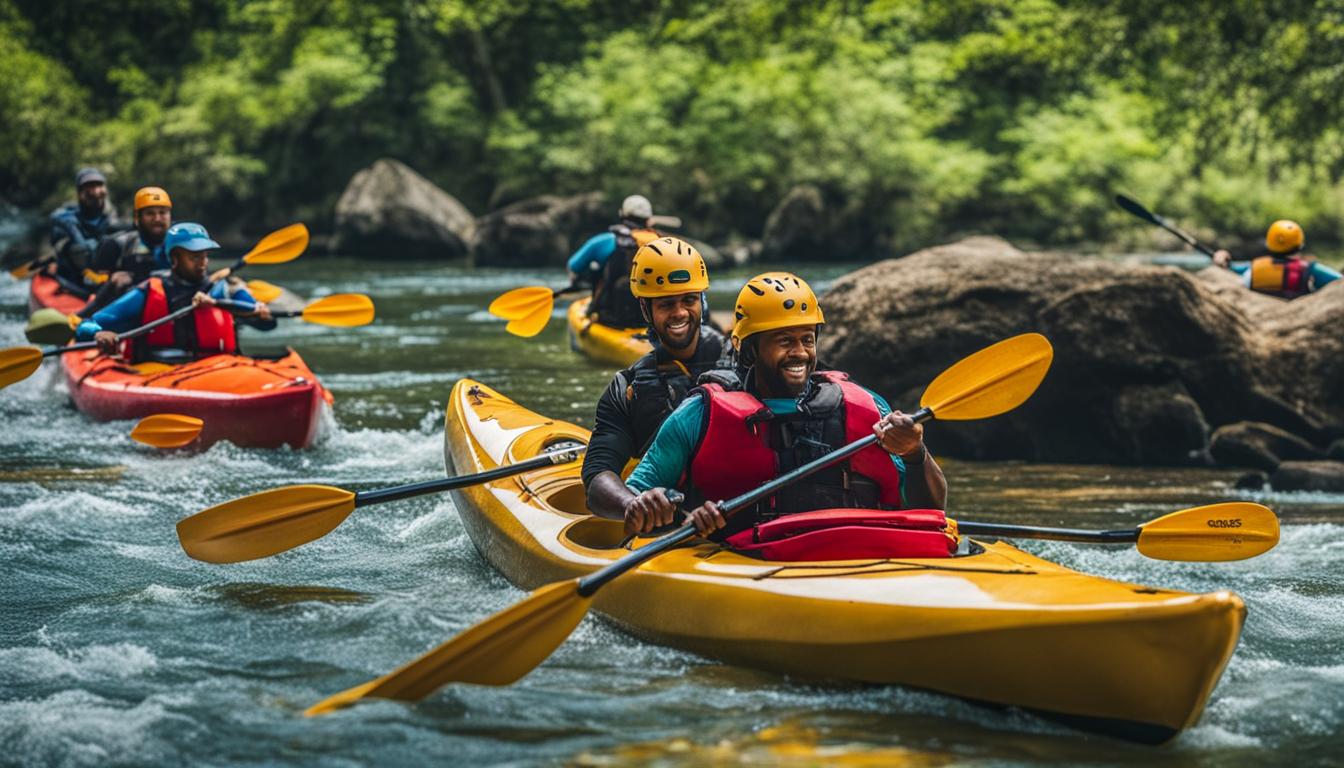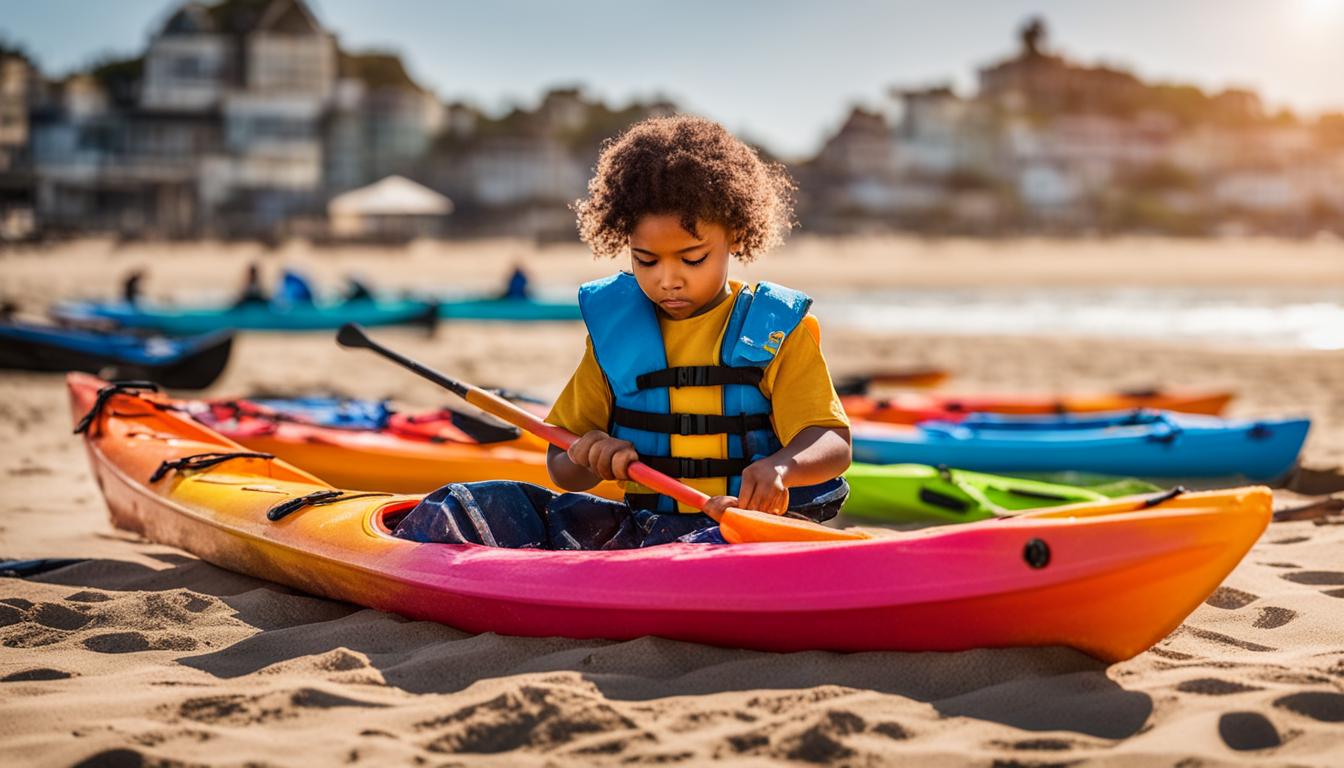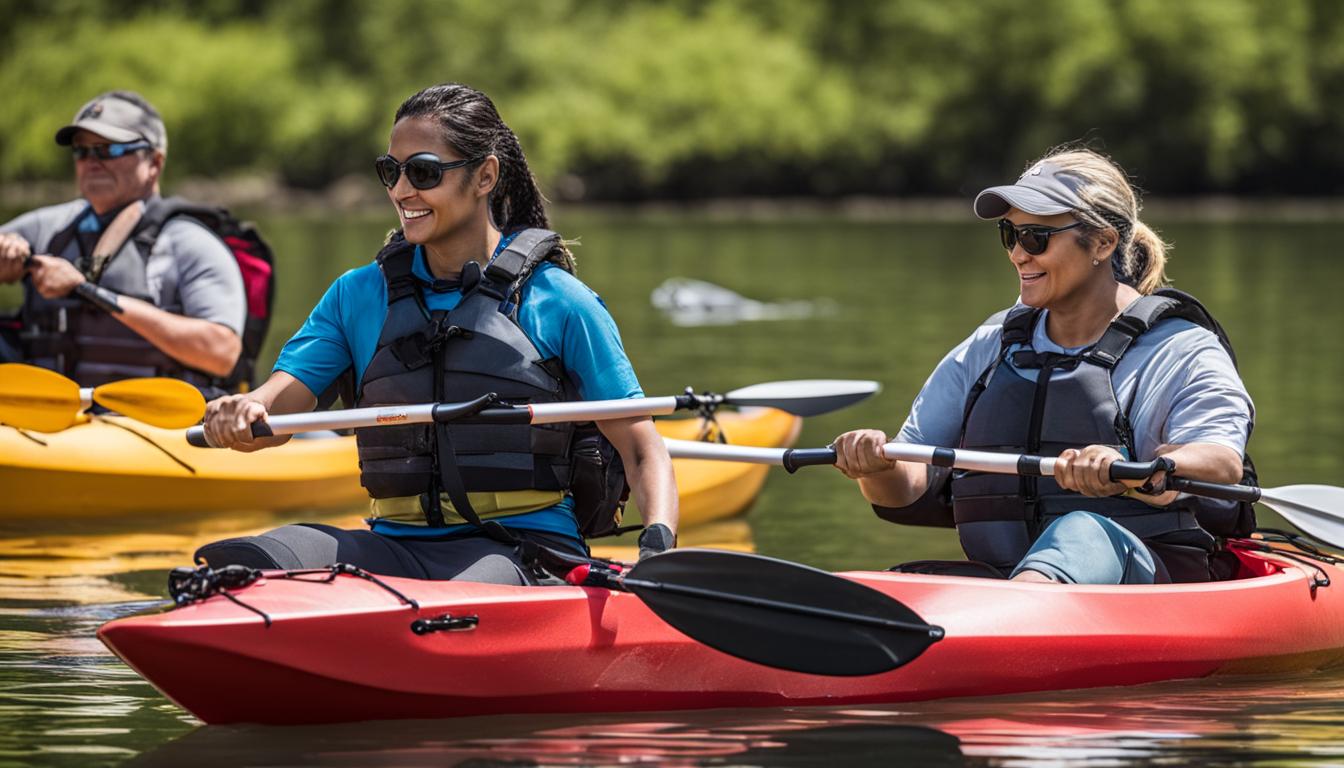Kayaking is not only a thrilling outdoor activity, but it also offers a world of fascinating facts and educational resources for kids. Whether they’re exploring calm lakes or navigating rushing rivers, kayaking provides endless opportunities for adventure and learning. So, let’s dive into some interesting kayaking facts and discover the wonderful world of kayaking!
Key Takeaways:
- Kayaking is a fun and exciting outdoor activity for kids.
- It offers a unique opportunity to learn about nature and the environment.
- Kayaking can help children develop important skills, such as coordination and risk evaluation.
- There are many educational resources available to guide kids in understanding kayaking.
- Exploring different kayaking destinations can create lasting memories and bring families closer together.
The History of Kayaking
Kayaking has a fascinating history that spans over 4,000 years. It originated with the indigenous Inuits and Aleuts, who used kayaks for transportation and hunting. These early kayaks were made from animal skin and bones, making them lightweight and maneuverable in the water. In fact, the word “kayak” itself comes from the Greenlandic Inuit language and means “hunter’s boat”.
One of the oldest surviving kayaks, dating back around 450 years, can be found on display in a museum in Munich, Germany. This remarkable piece of history provides a glimpse into the ingenuity and craftsmanship of early kayak builders.
While kayaking as a sport didn’t gain popularity until the 1970s, it has since become a beloved activity for millions of people. In the United States alone, over 18 million individuals now engage in kayaking. It’s no wonder that this water sport has captivated the hearts of people all around the world.
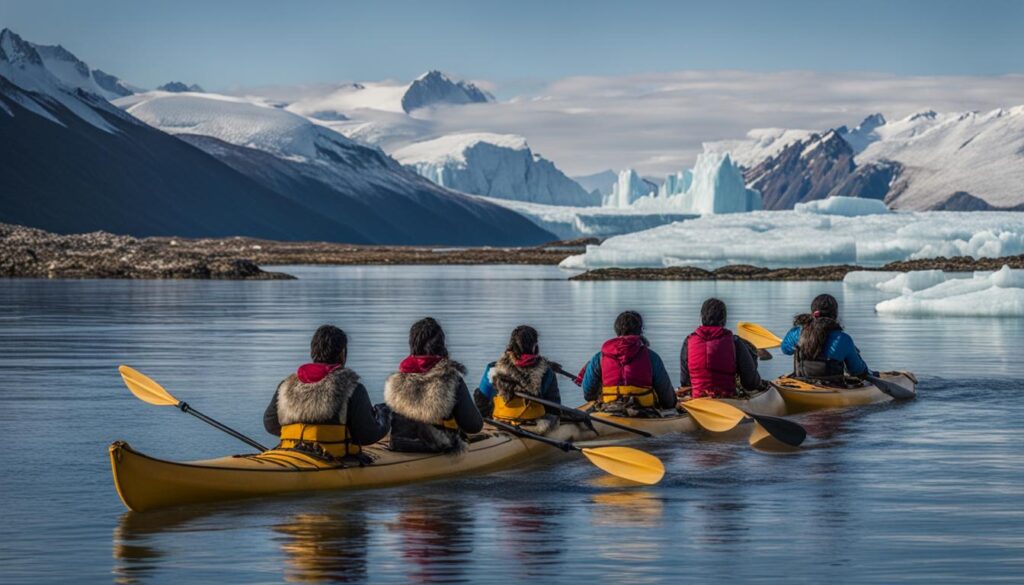
The Evolution of Kayaks
“The evolution of kayaks has been truly remarkable. From the simple animal skin and bone constructions of the past, modern kayaks now feature advanced materials like fiberglass and carbon fiber, making them lighter, more durable, and incredibly efficient in the water.” – Kayaking Expert
Today, kayaks come in a variety of designs, each with its own unique set of features. Some are built for speed and performance, while others prioritize stability and maneuverability. There are even specialized kayaks for fishing, surfing, and whitewater adventures. The versatility of kayaks has made them a favorite among outdoor enthusiasts of all ages.
| Kayak Design | Unique Features |
|---|---|
| Recreational Kayaks | Stable, easy to maneuver, ideal for beginners |
| Sea Kayaks | Long and narrow for increased speed and efficiency |
| Whitewater Kayaks | Durable, with reinforced hulls and maneuverability |
| Touring Kayaks | Designed for long-distance paddling and storage capacity |
The evolution of kayaks has allowed people to explore and enjoy the beauty of nature in ways that were once unimaginable. Whether you’re gliding across calm lakes, navigating through roaring rivers, or braving the ocean waves, kayaking continues to be an exciting and fulfilling adventure.
Fascinating Kayaking Facts
Kayaking is a thrilling water activity that offers both fun and adventure for kids. Here are some engaging kayaking facts that will spark their curiosity:
- Kayaking is a recognized sport in the Olympics, showcasing the skill and athleticism of the participants.
- Did you know that the farthest distance traveled by kayak on ocean water in 24 hours is an astonishing 141.2 miles? That’s like kayaking from one side of a large city to another!
- If you ever see someone rolling an overturned kayak back up, they’re executing a move called Esquimautage. It’s a French term for a technique used to right a capsized kayak.
- There are various kayak designs, each tailored for different purposes and environments. Some are built for speed, while others prioritize stability or maneuverability.
- Even famous celebrities like Pope John Paul II have been known to enjoy kayaking as a recreational activity. It’s a hobby that appeals to people from all walks of life.
- For the thrill-seekers, the world record for the steepest drop in a kayak stands at an incredible 189 feet! That’s higher than a 15-story building!
- Besides being an exciting recreational pursuit, kayaking is also an excellent form of exercise that engages the entire body.
“Kayaking is not just about paddling, it’s about discovering new horizons and testing your limits. It’s a journey of self-discovery and a way to connect with nature.” – Unknown
Kayaking is a fantastic way for kids to explore the wonders of the water and immerse themselves in thrilling adventures. It’s crucial to remember that while kayaking can be fun, safety should always be a top priority. Encourage children to wear life jackets, paddle with a buddy, and follow all necessary precautions to ensure a memorable and enjoyable experience.
Now that you know some fun kayaking trivia, get ready to embark on your very own kayaking journey!
| Fun Fact | Details |
|---|---|
| Total Distance Traveled in 24 Hours | 141.2 miles |
| Term for Rolling an Overturned Kayak | Esquimautage |
| Highest Steep Drop in a Kayak | 189 feet |
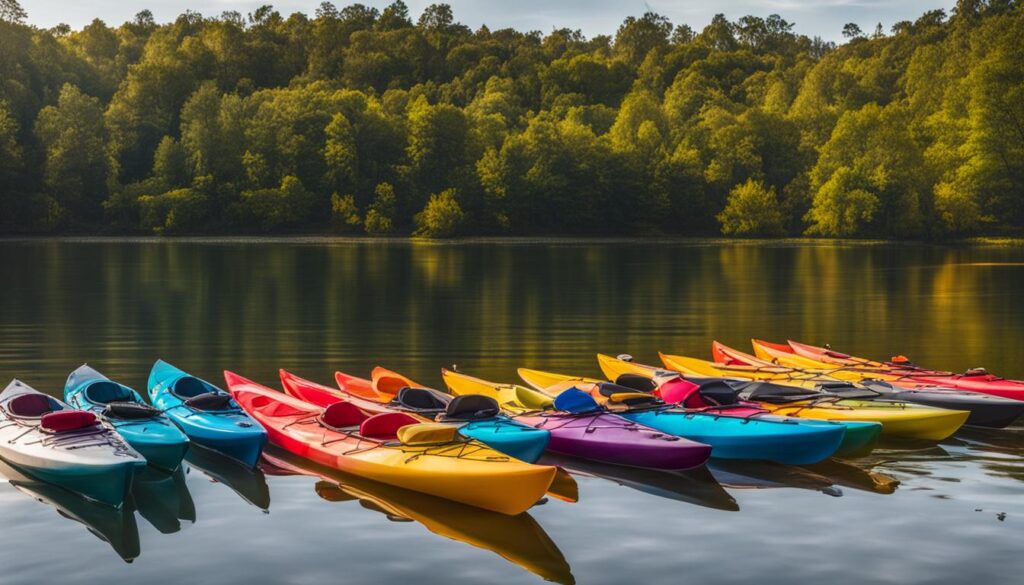
Kayaking Adventures and Travel
Kayaking is not just a fun activity, but it also allows you to embark on exciting adventures and explore breathtaking destinations. From serene lakes to rugged coastlines, kayaking can take you to places that are inaccessible by other means. It offers a unique opportunity to get up close and personal with nature, giving you a sense of freedom and tranquility.
One popular kayaking destination is Skookumchuck in Edgemont, BC. Here, you can paddle alongside seals, observe marine life, and even search for fascinating sea creatures. The area is known for its incredible surf waves, making it a great spot for experienced kayakers looking for an adrenaline rush.
Another awe-inspiring destination is the Bay of Fundy, which boasts the highest tides in the world. Located between New Brunswick and Nova Scotia, this natural wonder offers a truly immersive kayaking experience. Paddle through narrow channels and witness the dramatic tidal changes, creating a mesmerizing spectacle.
For those seeking more adventurous expeditions, kayaking can be a gateway to exploring remote areas. Families have embarked on journeys across North America, discovering hidden coves, secluded beaches, and stunning landscapes. Some have even ventured as far as Europe, paddling through picturesque canals and lakes.
| Kayaking Destination | Features |
|---|---|
| Skookumchuck | Surf waves, seals, marine life |
| Bay of Fundy | Highest tides, dramatic tidal changes |
| Remote areas | Hidden coves, secluded beaches, stunning landscapes |
| Europe | Picturesque canals, serene lakes |
Kayaking not only allows you to explore nature’s wonders but also brings families closer together. It creates an opportunity for shared experiences, teamwork, and bonding. Whether it’s a peaceful paddle on a calm lake or an exhilarating adventure in rough waters, kayaking can create lasting memories for youngsters and adults alike.
So, grab a paddle, learn about kayaks for kids, and embark on your own kayaking adventure. Discover the beauty of untouched landscapes, connect with nature, and create memories that will last a lifetime.
Benefits of Kayaking for Kids
Kayaking is a fantastic activity for kids that offers numerous benefits for their physical and mental development. Not only does it provide an exciting outdoor adventure, but it also serves as a valuable learning experience. Here are some key benefits of kayaking for children:
Physical Fitness and Coordination
Kayaking requires paddling through water, which is an excellent form of exercise. It helps strengthen muscles, improve cardiovascular fitness, and enhance overall physical coordination. As kids maneuver their kayaks, they engage their core, arms, and legs, promoting muscle development and endurance. Regular kayaking sessions can contribute to a healthier and more active lifestyle.
Developing Essential Skills
Kayaking is not just about paddling; it also teaches kids important life skills. As they navigate the water, children learn to control their fears, evaluate risks, and make decisions. They develop problem-solving skills by analyzing the water currents, adjusting their paddling techniques, and adapting to changing conditions. Kayaking also fosters teamwork and communication, especially when kids paddle in tandem kayaks and coordinate their movements.
Environmental Awareness and Science Exploration
Kayaking offers a unique opportunity for kids to connect with nature and learn about the environment. As they explore rivers, lakes, and coastlines, children can observe various aquatic ecosystems, spot wildlife, and discover the impact of human activities on natural habitats. This hands-on experience can spark an interest in environmental science and promote a sense of responsibility towards preserving our natural resources.
| Benefits | Details |
|---|---|
| Physical Fitness | Kayaking provides a full-body workout, strengthening muscles and improving cardiovascular fitness. |
| Coordination | Maneuvering a kayak requires coordination of the core, arms, and legs, enhancing motor skills. |
| Problem-solving | Kayaking teaches kids to analyze and adapt to different conditions, fostering problem-solving skills. |
| Teamwork | Paddling in tandem kayaks promotes teamwork and communication between kids. |
| Environmental Awareness | Exploring natural habitats raises kids’ awareness of the environment and the need for conservation. |
Overall, kayaking offers a fun and educational experience for kids. It nurtures their physical fitness, builds essential skills, and instills a sense of respect for the environment. By introducing children to the world of kayaking, we can foster their love for nature and provide them with lifelong benefits.
Conclusion
Kayaking is a fun and educational activity for kids. Whether they’re interested in learning kayaking fun facts or exploring the history of this fascinating water sport, there are plenty of resources available to keep them engaged. From the ancient origins of kayaking to the modern-day adventures and competitions, there’s always something new and exciting to discover.
Not only does kayaking provide an opportunity for children to get outside and enjoy the water, but it also offers a range of benefits. It helps develop important skills like risk assessment, problem-solving, and physical coordination. Plus, it’s a great way to stay active and explore the natural world.
So, if your kids are looking for a thrilling and educational activity, kayaking is a fantastic choice. Let them dive into the world of kayaking trivia, explore educational resources, and embark on exciting adventures. Whether they’re paddling on calm lakes or braving the ocean waves, kayaking is sure to create lasting memories and foster a love for the great outdoors.
FAQ
Can kids kayak on their own?
While some kids may be able to kayak solo, it is always recommended to have an adult present for supervision and safety.
What safety precautions should kids take when kayaking?
Kids should always wear a properly fitted life jacket when kayaking and follow basic water safety guidelines.
What is the difference between a canoe and a kayak?
Canoes are wider and more stable, while kayaks paddle lower to the water and can go faster. Canoes are typically used for storage and leisure, while kayaks are more suitable for sport and exploration.
Can kids kayak in the ocean?
Yes, kids can kayak in the ocean, but it is important to have proper training and knowledge of ocean conditions before venturing out.
How can kids learn more about kayaking?
Kids can learn more about kayaking through educational resources such as books, websites, and even local kayak clubs or organizations that offer youth programs.
Are there any age restrictions for kayaking?
Age restrictions may vary depending on the location and specific kayak tour or program. It is best to check with the operator or instructor for age requirements.
Can kids kayak in rivers and lakes?
Yes, kids can kayak in rivers and lakes. These calm bodies of water provide safe and enjoyable environments for kids to explore and paddle.
How can kids get started with kayaking?
Kids can start kayaking by taking lessons or joining a youth kayaking program. This will provide them with the necessary skills and knowledge to kayak safely and confidently.
Are there any risks associated with kayaking?
Like any water activity, kayaking does come with some risks. It is important for kids to understand and follow safety guidelines, and to always kayak under adult supervision.
Can kayaking help kids stay active and healthy?
Yes, kayaking is a great form of exercise that helps improve physical fitness, strength, and coordination. It also encourages kids to spend time outdoors and connect with nature.

